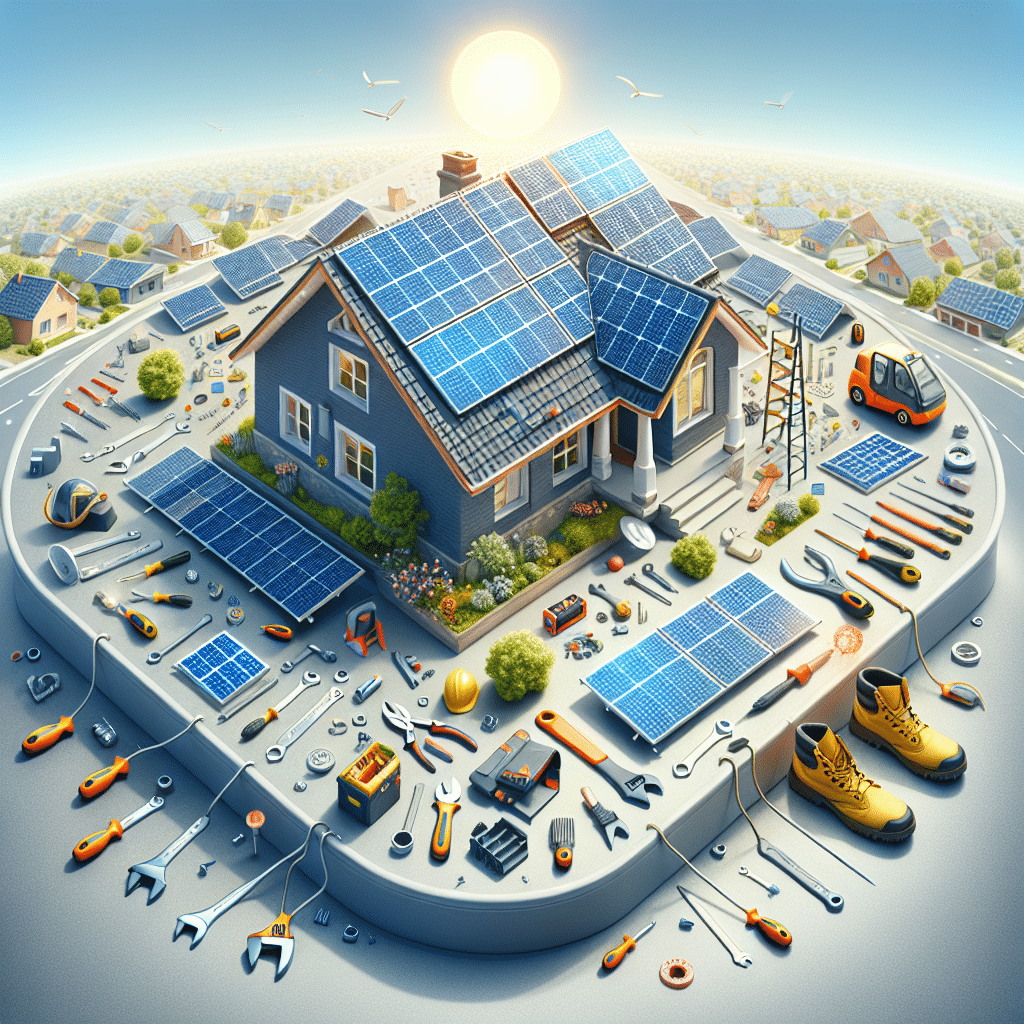Understanding Solar Energy
Solar energy harnesses sunlight and converts it into electricity, making it an environmentally friendly and sustainable energy source. Residential solar panel systems typically consist of photovoltaic (PV) panels, an inverter, mounting equipment, and a monitoring system.
Step 1: Solar Energy Assessment
Evaluate Your Home’s Solar Potential
- Roof Orientation and Angle: South-facing roofs capture the most sunlight, while east and west-facing roofs can also work, albeit less efficiently. Roof angles between 15 and 40 degrees are optimal.
- Shade Analysis: Trees, buildings, or other obstructions can cast shadows. Use a solar pathfinder or consult solar analysis tools to evaluate shading patterns throughout the day.
Energy Consumption Review
- Review your past 12 months of energy bills to determine average usage. This helps estimate the system size required.
Site Assessment
- Consider local climate, averaging sunlight hours per day, and seasonal weather patterns to design an efficient system.
Step 2: Determining System Size
Calculate Your Energy Needs
- Use your energy bill to calculate average daily usage (kWh). Divide your monthly usage by 30 to find daily needs. Consider peak sun hours when determining how many panels you’ll need.
Panel Output Estimation
- Standard solar panels generate between 250-400 watts each. For instance, if you use 30 kWh/day and live in an area receiving 5 sunlight hours daily, divide 30 kWh by 5 hours, resulting in 6 kW. If using 350-watt panels, you’d need approximately 17 panels (6000 watts divided by 350 watts).
Step 3: Exploring Financing Options
Choosing the Right Financing Model
- Outright Purchase: Pay upfront for panels and installation—best for long-term savings.
- Solar Loans: These allow you to finance installation through monthly payments.
- Leases and Power Purchase Agreements (PPAs): You can lease panels or pay for the electricity they generate, often with little to no upfront cost.
Incentives and Rebates
- Federal and state tax credits, such as the Federal Solar Tax Credit, can significantly reduce initial costs. Research local incentives for further savings.
Step 4: Selecting Your Solar Panel System Components
Types of Solar Panels
- Monocrystalline: Most efficient and aesthetically pleasing but generally cost more.
- Polycrystalline: Less efficient but more affordable. Suitable for a larger space.
- Thin-Film: Lightweight and flexible, making them easier to install, but less efficient than crystalline panels.
Inverters
- Choose between string inverters, microinverters, or power optimizers. String inverters are cost-effective, while microinverters enhance performance in partially shaded areas.
Mounting Systems
- Select based on roof type: rooftop mount for sloped roofs, flat roof mounts, or ground-mounted systems for homes with adequate land.
Step 5: Hiring a Solar Installer
Research Potential Installers
- Look for companies with experience, positive reviews, and proper licensing and insurance. Check their warranty offerings as well, which should cover both equipment and workmanship.
Get Multiple Quotes
- Compare at least three quotes for transparency and a better understanding of market rates. Ensure each quote outlines equipment, installation, warranties, and financing options.
Step 6: Solar Panel Installation Process
Permitting and Paperwork
- Once you choose an installer, they will help you obtain necessary permits and approvals from local government and utility providers.
Installation Day
- Preparation: The installation team will ensure your roof is ready—checking for repairs or reinforcements if needed.
- Panel Mounting: Panels are mounted onto the chosen structure, ensuring they are securely fastened.
- Electrical Connections: The installer connects the panels to the inverter and the home electrical system, then ensures safety protocols are followed.
Inspections and Interconnection
- After installation, your system will undergo inspection by local authorities. Once approved, connect to the utility grid to allow for net metering, where you can earn credits for surplus energy production.
Step 7: Monitoring and Maintenance
System Monitoring
- Many modern solar systems come with monitoring apps that track energy production, consumption, and system health in real-time.
Regular Maintenance
- Keep panels clean and free of debris. A quarterly inspection is recommended. If performance dips, contact your installer for troubleshooting.
Step 8: Understanding Grid Connection and Net Metering
Grid Connection Basics
- Your solar system is typically connected to the local utility grid. Any excess power generated can flow back into the grid, earning credits through net metering.
Benefits of Net Metering
- Offset your electricity costs by feeding excess power back into the grid. Understand how local rates and net metering policies affect your energy savings.
Step 9: Long-term Considerations
Performance and Efficiency
- Solar panels generally produce sufficient energy for 25-30 years. After this period, efficiency may decline, requiring replacement.
Future Upgrades
- Keep in mind the evolving technology in solar panels and batteries. As advancements occur, consider upgrades to enhance efficiency or energy storage.
FAQs
1. How much do solar panels cost?
- Costs can vary, typically ranging from $10,000 to $30,000, depending on system size, equipment quality, and local installation rates.
2. Will my solar panels work on cloudy days?
- Yes, solar panels can still generate electricity on cloudy days, though output may be reduced.
3. What happens at night?
- Solar panels do not generate electricity at night; however, a solar battery or grid connection can provide power.
4. Can I install solar panels myself?
- While DIY installation is possible, professional installation ensures compliance with safety standards and maximizes system efficiency.
5. How long does installation take?
- Depending on the system size and complexity, installation can take anywhere from one day to a week.
A thorough understanding of each of these steps will empower homeowners to make informed decisions and successfully harness solar energy, providing long-term savings and environmental benefits.
